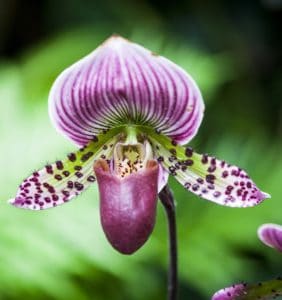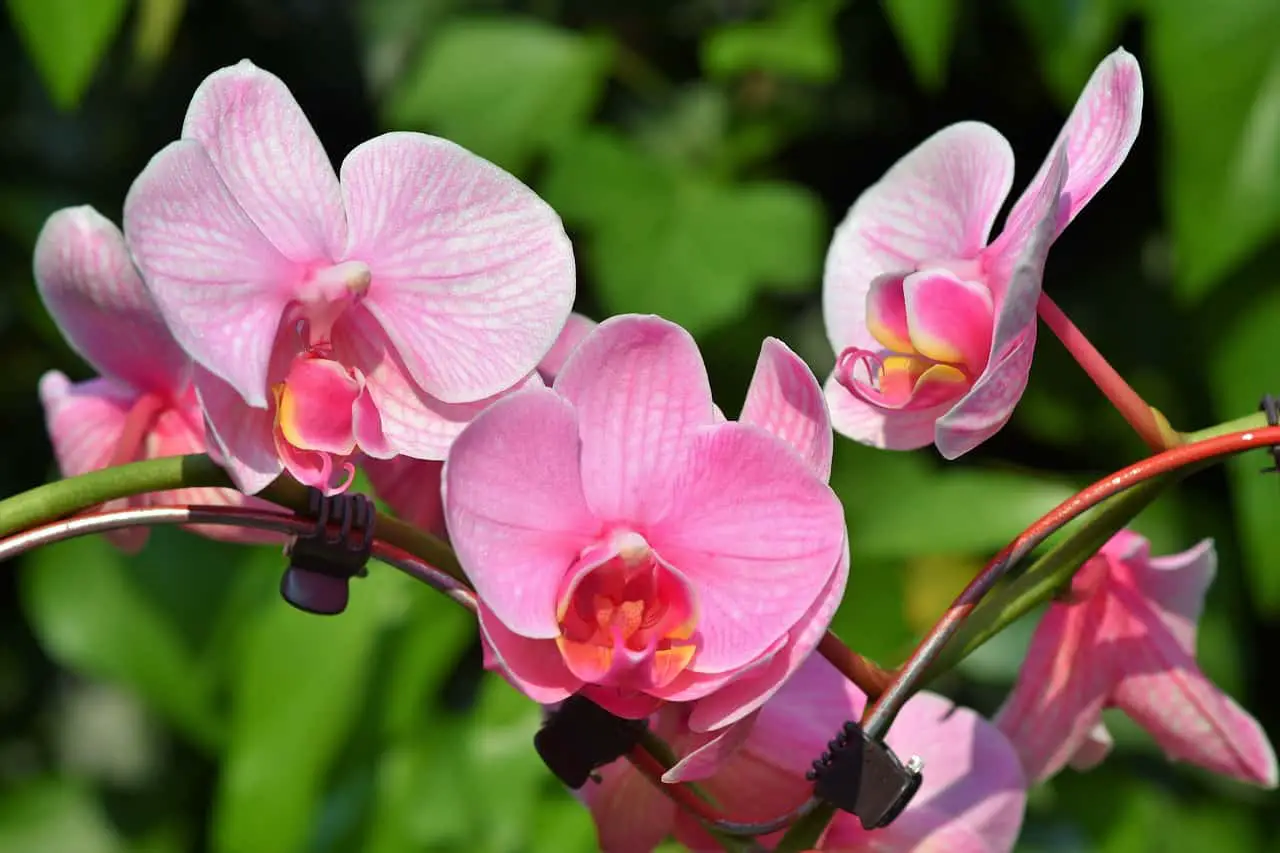Some links in the post are affiliate links and I get a commission from purchases made through some links found in the post.
Orchids are some of the most commonly grown houseplants. They are not like common potted plants used in homes.
They can be easy to grow if you have some know-how about their needs. Care of these plants is easy once you learn how to tend to them properly.
The most common variety of orchids grown in homes is “Phalaenopsis”.
They are either epiphytic i.e. grow anchored to other plants or terrestrial requiring a mix of potting soil, sand, perlite, and tree bark.
The potted varieties are usually terrestrial. They are very delicate and prefer filtered light, well-draining soil, and adequate water.
How Normal Leaves and Roots of an Orchid look like:
Plants tell you what’s wrong with them by showing changes in the appearance of their leaves and roots.
Normally, the leaves of a healthy orchid should look upright, stiff, and olive green in color. The roots vary from white to green in color.
When healthy, the roots are plump rigid and have bright green or slightly pinkish tips.
If the leaves are wrinkled or curled, then there is something wrong with the health of the plant. But once you have found the problem, you are bound to solve it in no time.
Causes of Wrinkled Orchid Leaves:
Wrinkled orchid leaves are a sign that the plant is not meeting adequate requirements and it needs a little bit of attention to get it back to normal.
Orchids prefer a moderately humid environment for their growth. They are a bit choosy when it comes to watering.
They neither like to be over-watered nor under-watered. Identification of the problem is the first step to fixing the issue.
The main reasons for an orchid leaves to wrinkle are due to underwatering, overwatering, problems with the soil, lack of humidity, root rot and high temperatures.
1) Underwatering Your Plant. Keeping it too dry!
 If the orchid is under-watered then the turgor pressure in the leaves will decrease and as a result, the leaves will appear limp, flaccid, and weak.
If the orchid is under-watered then the turgor pressure in the leaves will decrease and as a result, the leaves will appear limp, flaccid, and weak.
You should inspect the roots as well to check whether there they are ok or not. The roots growing out of the soil are usually white to green in color when they are healthy.
To confirm dehydration, it is better to take a look at the deeper roots. If they appear brown, brittle, or shriveled, then under-watering is the most probable cause.
2) Keeping it too Wet!
If the leaves appear wrinkled despite watering your orchid, then you must be overwatering it.
If you panic on noticing the limp leaves and start to overwater, the situation becomes even worse as the root system of the plant comes under pressure and is severely damaged.
Most orchids are damaged by overwatering rather than under-watering. Overwatering leads to root rot and many other diseases1.
This is a common mistake committed by beginners but knowing about this fact can help avoid the situation next time in the future.
To confirm the overwatering, we have to look at the roots as well. They appear very mushy and stringy black.
If the plant is given more water, the roots will eventually rot and the plant will not be able to take nutrients from the soil or growth media at all.
3) Medium/Culture Deterioration:
Leathery and wrinkled leaves may indicate a problem in the soil if the roots look healthy and have no visible deformities.
The medium may have lost most of the nutrients required for the optimum growth of the plant over time.
The reasons may also include overwatering or over-fertilization that disrupts the harmony and balance of the medium.
You should check the potting medium to see if it’s breaking down or not. In this case, the only remedy is to repot the orchid.
There are many potting mixtures available. The best mixture involves using a bark mix along with peat moss. The main purpose is to rejuvenate the living conditions of the plant.
4) Lack of Humidity:
Orchids thrive optimally in humid conditions. A 50-70% humidity is essential for their proper growth.
There is a continuous loss of water from the undersurface of leaves through the stomata.
They basically act as channels for the evaporation of water to keep the plant cool.
When the environment is less humid, there is a rapid loss of water in the form of vapors and this leads to dehydration of the plant.
When the environment is humid, the water loss is not that much and the uptake of water from the roots is in equal balance with the water lost through the leaves.
So, it is better to place orchids in a humid environment to prevent the leaves from wrinkling.
5) Root Rot and Crown Rot:
Wrinkled leaves can also be due to diseases that may damage the roots or leaves of the orchid plant.
The most common attacks to the root are fungal and bacterial which ultimately lead to the death of the root system.
They cause severe damage and paralyze the plant to take up nutrients for proper growth.
There is less absorbance of water as well which leads to wrinkled and limping leaves. Root rot is mostly a by-product of overwatering and it can easily be taken care of.
Crown rot is due to misting or watering the body of the orchid plant with water.
The crown of a plant means the parts above the ground which include stem, leaves, and flowers, etc.
The leftover water on the crown provides an environment for the growth of harmful organisms which causes damage to the leaves and the stem.
It rapidly leads to blackening of the crown area and results in the death of the plant.
If you are enjoying this article, check out our article on how to plant orchids in hanging baskets.
Solutions to Fix and Prevent Wrinkled Orchid Leaves
If you have identified any of the problems listed above, then you have already made 50% percent progress in solving the problem of your orchid plant.
You can follow these simple steps to fix the problem at hand and prevent them from occurring in the future:
1) Preventing the Dry Up of the Orchid Plant:
 When you have confirmed the features of dehydration in your orchid, the next step is to water the plant promptly.
When you have confirmed the features of dehydration in your orchid, the next step is to water the plant promptly.
The condition of the roots and leaves should be monitored daily to ensure that the plant gets watered as soon as the signs of dehydration start to appear.
You can also feel the weight of the pot when it is dry by lifting it. It will give you a rough estimate of how the pot feels like when the plant is dry.
So whenever you feel the plant has dried you can check it very easily by assessing the weight and water it accordingly.
2) Setting Up a Watering Routine to Prevent Overwatering:
The only way you can prevent over-watering is to prepare a definite watering schedule.
By assessing the pot regularly, you will have a get some idea about the duration after which the plant needs watering.
The gap between successive watering may change according to the weather but it’s mostly constant throughout.
Just add a few days between watering and check the potting medium before you water. If it seems wet, hold off the watering.
If you still don’t have a definite idea just don’t overdo it as overwatering kills orchids more than anything else1.
3) Removing Roots Affected with Root Rot:
The plant may develop root rot due to excessive soggy medium with super-added fungal attacks.
To solve this problem, you need to inspect the whole root system of the plant. All the roots affected by root rot are to be removed using clean shears.
This will prevent further spread of disease and is the only remedy you can use in this situation
4) Maintaining Humidity:
As mentioned earlier, orchid plants flourish in moderate humidity. For a start, you can use a humidity tray beneath the pot and fill it with water.
Fill the tray with gravel so the orchid pot sits on top of the gravel. Otherwise, the roots sit in water and they will rot very rapidly.
This method naturally raises the humidity level in the atmosphere. If the situation is grave, you can try to put a plastic bag over the plant which will emulate a greenhouse effect on it.
The wrinkled leaves will become stiff and rigid in no time if there is no underlying problem other than that.
The use of humidifiers is also appropriate but they are costly. If you don’t have the time to manually refill the water in the tray each time it dries up, then using a humidifier is a great option.
Placing the orchid alongside other houseplants is also a good strategy. Being surrounded by other plants helps keep the surrounding air moist and tepid.
5) Avoiding Showers and Misting of the Crown:
Showering or misting the stem or leaves of the orchid should be avoided at all costs. Both these actions can cause rotting of the stem and the crown.
They can also cause petal blight on the blooming flowers. So care should be taken to water the soil only and not soak to the crown unintentionally.
6) Repotting in New Medium:
If the growth medium has completely deteriorated, it’s time to repot the orchid with a new potting mix.
You can choose a new pot for the plant as well but orchids prefer to be potted snug. A clear, plastic pot with adequate drainage holes is recommended to use.
The potting mix should be a mix of peat moss, perlite, and tree bark. Using peat moss has the advantage of retaining water for a longer period.
So if u tend to underwater the plants, increasing the quantity of peat moss will help a lot.
What Causes Curled Orchid Leaves and How to Fix the Problem:
The main reason an orchid leaves will curl is due to leaves following the light source. If the light source changes direction regularly the leaves will curl.
Other reasons your orchid leaves will curl are pest infestations, fungal diseases, overwatering and an improper potting medium.
Following are the main reasons for curled orchid leaves:
1) Pest Infestation:
Orchids are very delicate plants and are very sensitive when it comes to pests.
Mealybugs and aphids are responsible for most of the damage done to the orchids when it comes to insect attacks.
They suck the sap from the plant which disrupts nutrient supply to the leaves.
This causes them to curl upwards as it is difficult for them to balance the tension provided by the cuticle on the exterior surface of the leaves.
Solution
The pests need to be dealt with as soon as possible. They should be eliminated at the earliest to not let them establish a stronghold over the plant.
You should remove any visible bugs manually by hand-picking them. The use of neem oil is also a great way to prevent further damage to the plant.
Neem oil is completely safe and is the best organic pesticide to use in such situations.
You may need to respray the plant with the oil after a week to kill any eggs or larvae that were missed the first time.
A mixture of diluted soap and water can also be used if you don’t have neem oil.
This is a simple yet effective homemade therapy but the spray needs to be repeated after every 2 to 3 days to ensure proper removal of the bugs.
Commercial pesticides can also be used but only if the infestation has grown too much. Orchids are very sensitive so they should be used judiciously.
2) Fungal Disease
The most common fungal pathogen which affects the orchid plant is Fusarium wilt. It primarily chokes the vascular system of the plant.
The fungi enter through the roots and damage the water-conducting vessels of the plant.
As the infection spreads, the fungus causes water restriction to the leaves which results in curling and yellowing of the leaves.
Solution
It is best to remove the stricken roots with the help of sterile shears. Removing any small weeds around the plant is a must as they host the disease pathogen.
If the infection has spread massively, then throw away the infected rhizome and repot the plant in a new potting mixture.
3) Other Causes:
Other causes of curled orchid leaves include
- Overwatering
- Change in the direction of the light source
- Improper potting media
Final Thoughts: How Can You Prevent Wrinkled or Curled Orchid leaves?
Orchids are very beautiful and captivating when compared to other plants. They have a league of their own and are always able to attract the attention of flower lovers.
There are millions of people who are exclusively dedicated to growing these magnificent plants.
Though orchids demand a little more effort, caring for and maintaining them is an absolute joy.
Problems such as wrinkled and curled leaves are pretty common and can be taken care of in no time.
The steps mentioned above are more than enough for a beginner gardener to fix these issues. Knowing all this information will prove fruitful if the need ever arises.
Just make sure to keep a steady check on watering and most of the problems won’t even occur. Orchids will do far better with too little fertilizer than with too much.
You can give balanced fertilizer twice in summers as it is the time of peak growth. In winter you can fertilize only once.
Ensuring all these steps will prevent wrinkled and curled leaves of your favorite orchid plant for sure.
Before you go, here are some more related articles I encourage you to read below to help solve more of your gardening issues:
Calathea Ornata Leaves Curling
Why Are My Hydrangea Leaves Curling
How Do You Revive A Dying Calla Lily
About the Author:
Saad Ansar
Saad is an avid gardener himself and is a great lover of plants, animals, photography, & people. Currently, he is focused on photographing indoor plants & captioning beautiful outdoor sceneries. He writes and rewrites in-depth articles on nature and science.


